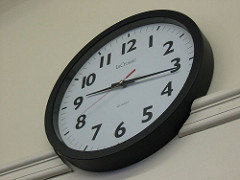Managing lesson time
By Mary Bigelow
Posted on 2015-10-25
 As a beginning science teacher, I have issues with time management. Some days a lesson I thought would take the entire class period doesn’t. Other activities take longer than I planned. How do teachers handle this? —D., Vermont
As a beginning science teacher, I have issues with time management. Some days a lesson I thought would take the entire class period doesn’t. Other activities take longer than I planned. How do teachers handle this? —D., Vermont
It’s a challenge for science teachers to design activities and investigations that fit into our allotted time. Secondary teachers deal with projects and investigations that don’t always fit neatly into 45- or 60- or even 90-minute packages. (One of my challenges was a class split in half by a lunch period!) Elementary teachers may have more flexibility, but time for science can be affected by schedules for specials or limited by a focus on reading and math.
Some curriculum documents or lesson plans have recommendations on how much time to allow. But even if you teach the same lesson to several classes on the same day, you’ll find that the time required may differ based on student interest and experiences, distractions, interruptions, or equipment glitches.
As you get to know your students and after teaching a lesson or activity a few times, you’ll get a feel for the time required. I would suggest annotating your lesson plans at the end of the day for future reference. How much time did the activity take? How much progress did each class make (if you teach more than one)? What affected the amount of time? What should be done differently next time?
I posed your question to a colleague, and she suggested from her experiences that it’s better to overplan than to wind up with a lot of extra time. She also recommended choosing activities that fit within your class period or can be paused and continued the next day.
It may take some work at first, but it’s good to have a repertoire of backup activities for days (or class periods) when an activity finishes early. These could include vocabulary games, time for students to update science notebooks, card sorts, or quick writes (responding to an open-ended question or prompt). The books in Page Keeley’s Uncovering Student Ideas series from NSTA have short “assessment probes” that challenge students and provide insight into their thinking. You could choose ones related to your current topic or that preview upcoming topics.
You probably can’t control the length of the class periods, but you can maximize the time you have. It’s important to have routines in place for the beginning and end of the class period to avoid spending time on logistics. Bell-ringers at the beginning of the class period can focus students’ attention on the lesson. Students having assigned roles for lab activities and established procedures for collecting or distributing materials can help make for smooth transitions between activities.
At the end of the class, students are tempted to race out the door. Keep an eye on the clock to have time for clean up. Plan for a brief exit activity or discussion to help students reflect on or “pack up” what they were learning or doing before they leave.
But even with careful planning, some individual students may finish a lesson or activity with time to spare. If you tell students to “get busy on something,” what students find to do on their own is often distracting to others or not related to science learning. Be ready with related resources for these students as others continue: an extension to the activity, a collection of reading materials, vocabulary reviews, or online resources or apps to examine.
One thing you’ll learn is that teachers have to be flexible!
Disclaimer: The views expressed in this blog post are those of the author(s) and do not necessarily reflect the official position of the National Science Teaching Association (NSTA).


